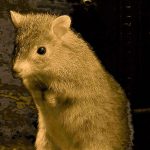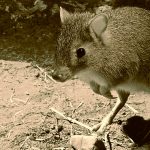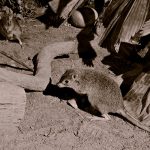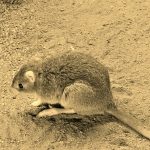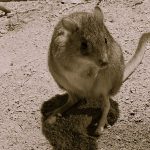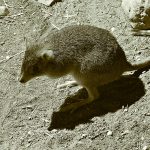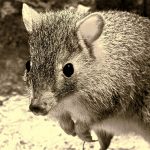NORTHERN BETTONG
(Bettongia tropica) Threatened species
The Northern bettong: A Hidden Treasure of Queensland
Deep in the gentle shade of northern Queensland’s woodlands lives a creature both rare and remarkable—the Northern bettong. Endemic to this small stretch of Australia, the bettong’s story is both compelling and urgent, intertwining the delicate threads of survival, adaptation, and the quiet resilience of nature.
A Home of Secret Burrows
Imagine walking at dusk through the open forests and sclerophyll woodlands of the Atherton Tablelands. The air is cool and scented with eucalyptus, and underfoot, soft grass hides intricate tunnels. These are not just holes in the ground; they are the carefully crafted burrows of the Northern bettong. Each burrow may have multiple entrances, nesting chambers, and discreet storage rooms for precious food—testament to this small marsupial’s resourcefulness.
- Habitat: Open woodlands, sclerophyll forests, and grassy areas with thick undergrowth.
- Range: Endemic to a restricted area in northern Queensland, with only two known wild populations near Mareeba.
Nighttime Foragers
As the sun sets, the forest floor begins to stir. By moonlight, a compact figure—no more than thirty centimetres from head to rump—emerges from its hidden home. The Northern bettong, with its soft, brownish-grey fur, light underbelly, short rounded muzzle, and alert, long ears, starts its nightly journey. Its prehensile tail—long and versatile—helps balance and even carry nesting materials.
Sensory Details:
- Visual: Dusky shadows and the gentle gleam of the bettong’s eyes reflect the moonlight as it navigates through tall grass.
- Auditory: The subtle rustle of grass and the faint sound of digging claws cut quietly through the night.
- Tactile: The bettong’s fur is exceptionally soft, protecting it from cool night breezes as it forages.
Underground Dining: A Gardener of the Forest
Guided by a sensitive nose and strong forelimbs, the Northern bettong is an expert at seeking hidden treasures underground. Roots, bulbs, tubers, and, most importantly, truffles and other fungi fill its menu. By feasting on these underground delicacies, bettongs accidentally assist the forest: dispersing spores and seeds, thus nurturing new life and sustaining the delicate balance of their ecosystem.
| Diet | Ecological Role |
|---|---|
| Roots, bulbs, tubers | Soil aeration and seed dispersal |
| Fungi | Fungal spore dispersal and forest health |
| Grasses, seeds, fruit | Maintaining ground vegetation diversity |
Threats in the Shadows
The story of the Northern bettong is shadowed by danger. Introduced predators such as foxes, dogs, and cats stalk the same forests, and the modern world has brought habitat loss and fragmentation. Once widespread, the population is now fragmented—estimated at just about 1,000 individuals in the wild.
Key Threats:
- Habitat destruction from land clearing and development.
- Predation by non-native animals.
- Isolation of remaining populations, reducing genetic diversity.
Conservation: A Shared Responsibility
The quiet work of the Northern bettong is essential for the health of Queensland’s woodland ecosystems. Their unique way of life—burrowing, foraging, dispersing—reminds us that every species plays a part in the story of the Earth. Ensuring their survival is not just about preserving one species, but safeguarding the complexity and beauty of an entire region.
What Can Be Done:
- Support habitat protection and restoration projects.
- Promote predator control programs.
- Raise awareness about the plight of Australia’s lesser-known marsupials.
The Northern bettong is more than a biological curiosity; it is a living chapter in Australia’s natural heritage. As we stand at a crossroads, their future depends on understanding, respect, and collective action. By learning about and valuing such creatures, we become their custodians, ensuring that the gentle rustle of bettong paws continues to be heard under the Queensland stars for generations to come.
Let us remember: When we protect the small and hidden, we preserve the greatness of the wild itself.

